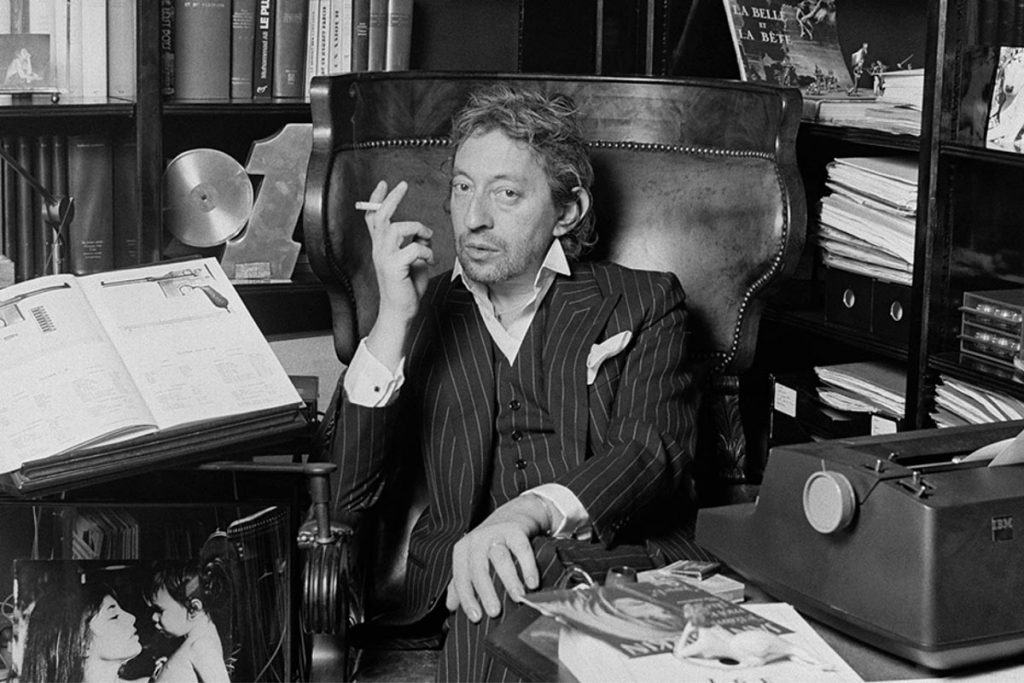Serge Gainsbourg’s books and manuscripts exhibited at the Bpi
UPDATE – MAY 2023: Due to its success, the exhibition is extended until September 3, 2023!
From January 25 to September 3, 2023, with Serge Gainsbourg, le mot exact, Bpi is hosting an exhibition that offers a thematic journey exploring the very special relationship that the artist had with more than 500 songs to literature.

The exhibition Serge Gainsbourg, le mot exact, which presents precious manuscripts and annotated typescripts, personal objects, small papers, books from his library and archival documents, is built around three thematic parts.
As soon as you enter the exhibition, the photo of Serge Gainsbourg at his office, in which he wrote most of his texts, welcomes visitors, inviting them to enter into the intimacy of his creative process.
The first part of the exhibition focuses on Serge Gainsbourg’s library and its literary influences, metaphorically placing the artist’s personal library at the heart of the Bpi. It offers an overview of the heterogeneous literary landscape of Serge Gainsbourg, by proposing a selection of the books which fill the shelves of his office in the rue de Verneuil and which shed light on the references and inspirations of the artist: classical literature, literature of the 19th century, poetry, surrealism and the Dada movement, works devoted to cinema, biographies of musicians, pop culture… This part also presents handwritten dedications by various authors.
It also shows how Serge Gainsbourg’s literary references influenced his writing, with parallels between certain texts by literary authors and his songs: Charles Baudelaire and Edgar Allan Poe / Initials BB; Francis Picabia / Fuir le bonheur de peur qu’il ne se sauve; Vladimir Nabokov / Jane B…
The second part of the exhibition focuses on how the literary influences of Serge Gainsbourg have shaped the character of the artist, until the creation of a media double that will end up almost eclipsing it,
in the tradition of 19th century literary doubles, as in Le Horla by Guy de Maupassant or Le portrait
by Dorian Gray by Oscar Wilde. The influence of some of these characters is striking in the construction of
the image of Serge Gainsbourg. The many personal objects exhibited (canes, perfumes, gloves, etc.), as well as his
“petits papiers”, loyalty cards for restaurants, nightclubs or luxury boutiques, come to feed the
legend and bear witness to this meticulous construction. The deciphering of the concept albums L’Homme à tête de chou and Melody Nelson further accentuates this highlighting of the double, until the creation of a new
character in the early 80s: Gainsbarre.
Finally, the third part of the exhibition highlights the Gainsbourg “style” as a lyricist. Master in the use of the French language, Serge Gainsbourg leaves behind him an enormous corpus of more than 500 songs, for himself and for his interpreters, which explains his influence in the current French song. Songs marked by a sharp writing technique, where figures of speech, the musicality of words and rhythm take center stage. This part of the exhibition also highlights the work of writing with its performers, through emblematic songs (Attends ou va-t-en with France Gall, Sous le soleil with Anna Karina, Alice hélas with Catherine Deneuve), until the analysis of the “production” of three songs written in 1968, representative of this writing work: L’Anamour, Ford Mustang and
L’enfant qui dort, whose handwritten lyrics and scores are exhibited to the public for the first time.
The epilogue of the exhibition finally demonstrates through newspaper headlines, how much the words of Gainsbourg have been able to leave a trace to the point of sometimes passing into everyday language, like the title Je t’aime moi non plus, become an expression of ambivalence.
Publié le 02/05/2023 - CC BY-SA 4.0
